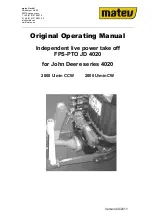
56
New belt will “bed in” and may require adjustment after ten hours service. Check the tension of a
new belt every 10 hours or daily within first 30 hours of operation.
The correct belt deflection is 8 mm.
If adjustment is required:
loosen the bolts securing the air compressor bracket to the engine block,
move the air compressor bracket up, until correct V-belt tension is achieved,
tighten the bolts securing the bracket and re-check the tension.
Fig. 5.13.2 Air compressor
1-Compressor, 2- Engage
lever, 3-Compressor V-belt
pulley, 4-Compressor
bracket.
Fig. 5.13.3 Rear of the tractor
1- Quick couplers (see description in 4.5.2). 2- Seven
pin socket. 3- Coupler of single line trailer air braking
system. 5- Hydraulic lift rocker. 6- Transmission oil
level dipstick, 7-Transmission oil filler plug, 8- Supply
socket. 9 – Control socket. 10- PTO 1000 engage
sensor, 11- PTO 1000 selector lever.
Fig. 5.13.4. Air Pressure
regulating valve. 5-Air
regulating valve. 7-
Safety valve. 8-Tyre
inflating valve.
Air reservoir
The capacity of the air reservoir is 15 liters. The air reservoir ensures the compressed air supply to
the trailer air braking system. It prevents rapid pressure drop in the system when the trailer air
brakes are used frequently.
After 1200 hours of operation or after two years of operation, and then every 1000 hours or once a
year clean the reservoir thoroughly with detergents and blow through with hot air.
At every tractor inspection ensure that the air compressor is firmly secured.
A defective reservoir (cracks, indents, etc.) should be replaced by a new one immediately.
Fig. 5.13.1
Diagram of double
line air system.
1 - Air compressor.
2 - Pressure regulating valve.
3 - Air reservoir. 4 - Drain valve.
5 - Air pressure gauge. 6 - Air
pressure sensor. 7 - Air pressure
drop warning light. 8 –Trailer
braking valve. 9 – Parking brake
valve. 10 - Trailer braking control
valve. 11 - Equalizing valve.
12 - Coupling valve.
13 - Coupling valve red.
14 - Coupling valve yellow .






































